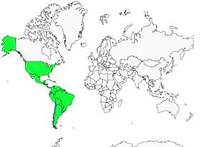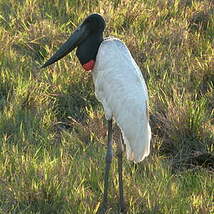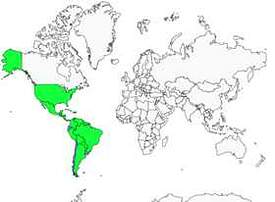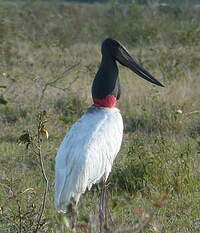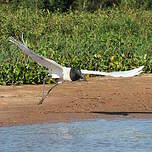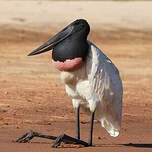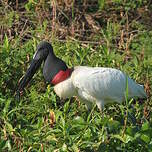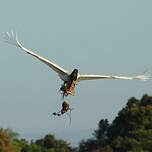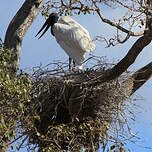Jabiru
Jabiru mycteria - Jabiru d'Amérique
Identification
The American Jabiru is one of a kind (Jabiru). It is one of the largest storks in the world, reaching heights of up to 1.6 meters (130-140 cm on average), having a wingspan of up to 3 meters and weighing up to 8 kg for the male. It can live up to 30 years.
It is easily recognizable, besides its large size, for its bi-colored appearance. It is all white with a bald head and neck and black. Its imposing bill, which can reach up to 35 cm, is also black and has a curled up appearance due to the concave culmen and convex gonys. The skin at the base of the neck is a vivid red over a variable extent. The legs are black. The only difference between the male and female is the size, with the male being about 25% larger than the female. The juvenile has gray feathers. Its plumage will become mostly white during the first winter, but the immature will keep brown feathers for its second year.
Subspecific information monotypic species
Foreign names
- Jabiru d'Amérique,
- Jabirú americano,
- tuiuiú,
- Jabirustorch,
- jabiru,
- Jabiroe,
- Jabirù,
- jabirustork,
- Jabirustork,
- jabiru veľký,
- čáp jabiru,
- Jabiru,
- jabiru,
- jabirú americà,
- żabiru amerykański,
- jabiru,
- Бразильский ябиру,
- ズグロハゲコウ,
- 裸颈鹳,
- jabirustork,
- 裸頸鸛,
Voice song and call
Habitat
Behaviour character trait
Flight
Dietfeeding habits
The Jabiru of America mostly feeds on fish, mollusks, reptiles and amphibians that it catches in shallow rivers and lakes. It finds its prey with both its sight and touch, sweeping its beak from side to side underwater.
During droughts, it also eats dead fish that are trapped in drying ponds to prevent them from rotting. In times of scarcity, it can also feed on small mammals.
Reproduction nesting
The breeding period corresponds, in almost all of its distribution area, to the end of the dry season (August-November in the Southern hemisphere) when it is easier to fish for fish in the drying up lakes and marshes.
The Jabiru couple is joined at least for the current breeding season. The nest is built in tall trees, often more than 10 meters from the ground. It can measure up to 1.80 meters in diameter. It is made of thick branches on the outside, finer branches, twigs and aquatic vegetation on the inside. It is reused and expanded from year to year.
The female lays 3 or 4 eggs. Both parents are involved in incubation, which lasts 60 days. The chicks are also fed by both parents and leave the nest after 3 months. After the departure from the nest, the parents continue to take care of it for some time. Given the duration of reproduction, most couples reproduce only one year out of two.
Geographic range
Threats - protection
Sources of information
- IOC World Bird List (v15.1), Gill, F and D Donsker (Eds). 2025-12-07.
- Birds of the World, The Cornell Lab of Ornithology
- Wiki Aves,
- A Field Guide to the Birds of Brazil, Ber Van Perlo
- Hanbook of the birds of the world - Vol 15, del Hoyo J., Elliott A. Christie D.
Other sources of interest
 Specification sheet created on
30/07/2023 by Dietmar Petrausch
Specification sheet created on
30/07/2023 by Dietmar PetrauschTranslation by AI Oiseaux.net
© 1996-2025 Oiseaux.net
- Accipitriformes
- Aegotheliformes
- Anseriformes
- Apodiformes
- Apterygiformes
- Bucerotiformes
- Caprimulgiformes
- Cariamiformes
- Casuariiformes
- Charadriiformes
- Ciconiiformes
- Coliiformes
- Columbiformes
- Coraciiformes
- Cuculiformes
- Eurypygiformes
- Falconiformes
- Galliformes
- Gaviiformes
- Gruiformes
- Leptosomiformes
- Mesitornithiformes
- Musophagiformes
- Nyctibiiformes
- Opisthocomiformes
- Otidiformes
- Passeriformes
- Pelecaniformes
- Phaethontiformes
- Phoenicopteriformes
- Piciformes
- Podargiformes
- Podicipediformes
- Procellariiformes
- Psittaciformes
- Pterocliformes
- Rheiformes
- Sphenisciformes
- Steatornithiformes
- Strigiformes
- Struthioniformes
- Suliformes
- Tinamiformes
- Trogoniformes


